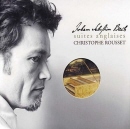|
|
English Suites BWV 806-811
Christophe Rousset (Harpsichord)
Bach's English Suites from Christophe Rousset
|
K-4 |
J.S. Bach: Suites anglaises |

|
|
English Suites BWV 806-811 [22:42, 21:16, 18:12, 18:45, 19:09, 25:47] |
|
Christophe Rousset (Harpsichord) |
|
Ambroisie |
Feb 2003 |
2-CD / TT: 126:14 |
|
Recorded at Neuchâtel, Switzerland.
Buy this album at: Amazon.com | Amazon.com |
|
Donald Satz wrote (May 20, 2004):
Comparison Versions: Curtis/Teldec, Gilbert/Harmonia Mundi
If want to know what this new Rousset/Bach set sounds like, just get yourself to the nearest airport hangar and turn on the juice. You will find the primary voices blurred and inner voices joined at the hip. Nuance will be hard to discern, while detailed architecture will be thoroughly hidden. You don't want to listen to music in an airport hangar? Neither do I, but recording engineers increasingly desire our attendance. This is a trend in recorded sound that I can't understand and find impossible to appreciate.
Let me state for the record that Chirstophe Rousset is a top-flight harpsichordist, but no performing artist can overcome the 'airport hangar effect'. For comparison, I used the exceptional versions of the English Suites from Kenneth Gilbert and Alan Curtis. All of a sudden, one notices the music's details and compelling musical lines; both versions are from an era where the hangar effect had no currency. Whatever Gilbert and Curtis are conveying strikes the listener incisively, but it is hard to figure out just what Rousset is trying to convey.
As for the style used by Rousset, I'd call it smooth contours and maximum exuberance. Also, these smooth contours mesh poorly with airport hangars, resulting in aural mush. I started out with the 1st Suite in A major. Although I have read that Rousset's interpretations lack feeling, I found his Sarabande quite poignant. That's likely because the Sarabande isn't as busy as the other movements in the Suite. I won't deny that Rousset's fast as lightning Bourree I and II and the Gigue have an exciting element to them, but you still can't discriminate among the various voices. Nothing is crisp, everything is muddled.
I could go on and offer my perceptions of Rousset's interpretations of the five other Suites, but there really isn't any point and I don't want to be overly repetitive. Some discs are doomed before they ever get off the ground, and the Rousset should have been deposited for posterity at the airport.
Don's Conclusions: To those who enjoy airport hangar sound, Rousset's set might be a godsend. For everyone else, it's one to avoid at all costs. Speaking of cost, I put out a significant amount of money to acquire this set and feel cheated out of hearing one of our best early music artists perform his magic. If there isn't a law forbidding such horrendous sound, someone should start lobbying for one. Any takers? An appropriate sentence would be 20 to life being stuck in an airport hangar listening to this pathetic sounding Ambroisie set. |
| |
|
Feedback to the Review |
|
Bradley Lehman wrote (May 21, 2004):
Donald Satz wrote:
< If want to know what this new Rousset/Bach set sounds like, just get yourself to the nearest airport hangar and turn on the juice. (...) Nothing is crisp, everything is muddled. (...) >
I like your sense of humor, Don! For what it's worth, the newest issue of American Record Guide (May/June 2004) has one by Haskins giving this set a mostly favorable review, with no complaint about the sound quality; he even asserts, "The harpsichord sounds fabulous and is recorded with clarity and depth."
I haven't heard the discs yet; it usually takes me quite a while to get around to buying Rousset's recordings anymore, especially in repertoire where I already have several others that I like. In the past, his playing hasn't held my interest very well. I like to hear more happening, and more obviously so in the performance, than merely a player being well-prepared with the notes...or a very carefully pieced-together recording, which his L'Oiseau-Lyre disc of Clavierubung II is, too obviously: there's even some regeneration on repeats, ugh. ("Regeneration" is using exactly the same take more than once in the editing to handle a repeat of the music. If done too blatantly, it makes the performance sound mechanical...for example, in Rousset's opening movement of 831. Close listeners, and those who play a piece themselves, can pick up on this readily, recognizing the sameness.)
Notes aren't the music, and there's more to it than lining them up perfectly and putting them out there (which he does very well). A faultlessly smooth surface just isn't good enough, in my opinion. |
| |
|
|
|